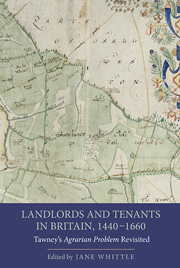Book contents
- Frontmatter
- Contents
- List of Figures
- List of Tables
- Abbreviations
- List of Contributors
- Acknowledgements
- Foreword
- Introduction: Tawney's Agrarian Problem Revisited
- 1 The Agrarian Problem, 1440–1520
- 2 Common Law and Manor Courts: Lords, Copyholders and Doing Justice in Early Tudor England
- 3 Negotiating Enclosure in Sixteenth-Century Yorkshire: The South Cave Dispute, 1530–1536
- 4 The Politics of Enclosure in Elizabethan England: Contesting ‘Neighbourship’ in Chinley (Derbyshire)
- 5 The Loss of Athelstan's Gift: The Politics of Popular Memory in Malmesbury, 1607–1633
- 6 In Search of the Scottish Agrarian Problem
- 7 The Transfer to Leasehold on Durham Cathedral Estate, 1541–1626
- 8 The Financial Rewards of Winning the Battle for Secure Customary Tenure
- 9 Risks and Rewards in Wasteland Enclosure: Lowland Lancashire c.1500–1650
- 10 Improving Landlords or Villains of the Piece? A Case Study of Early Seventeenth-Century Norfolk
- 11 The Agrarian Problem in Revolutionary England
- 12 Agrarian Capitalism and Merchant Capitalism: Tawney, Dobb, Brenner and Beyond
- Conclusions
- Select Bibliography
- Index
7 - The Transfer to Leasehold on Durham Cathedral Estate, 1541–1626
Published online by Cambridge University Press: 05 September 2013
- Frontmatter
- Contents
- List of Figures
- List of Tables
- Abbreviations
- List of Contributors
- Acknowledgements
- Foreword
- Introduction: Tawney's Agrarian Problem Revisited
- 1 The Agrarian Problem, 1440–1520
- 2 Common Law and Manor Courts: Lords, Copyholders and Doing Justice in Early Tudor England
- 3 Negotiating Enclosure in Sixteenth-Century Yorkshire: The South Cave Dispute, 1530–1536
- 4 The Politics of Enclosure in Elizabethan England: Contesting ‘Neighbourship’ in Chinley (Derbyshire)
- 5 The Loss of Athelstan's Gift: The Politics of Popular Memory in Malmesbury, 1607–1633
- 6 In Search of the Scottish Agrarian Problem
- 7 The Transfer to Leasehold on Durham Cathedral Estate, 1541–1626
- 8 The Financial Rewards of Winning the Battle for Secure Customary Tenure
- 9 Risks and Rewards in Wasteland Enclosure: Lowland Lancashire c.1500–1650
- 10 Improving Landlords or Villains of the Piece? A Case Study of Early Seventeenth-Century Norfolk
- 11 The Agrarian Problem in Revolutionary England
- 12 Agrarian Capitalism and Merchant Capitalism: Tawney, Dobb, Brenner and Beyond
- Conclusions
- Select Bibliography
- Index
Summary
R. H. Tawney identified the insecurity of leasehold tenure and increasingly commercial landlord policies as part of the agrarian problem of the sixteenth century. He suggested that landlords converted their estates from customary to leasehold tenure so that the ‘fruits of economic progress’ would no longer be retained by the peasant cultivators but would instead enrich the great landowners. This chapter discusses one dispute over the conversion of customary tenures to leasehold which suggests a greater variety of outcomes than Tawney anticipated. Most importantly, perhaps, it stresses that leasehold tenures came in a variety of forms, some of which benefited tenants more than others. The dispute developed on Durham Cathedral estate during the Reformation when the newly created Dean and Chapter of Durham tried to grant commercial leases to the tenants they had inherited from the suppressed Durham Priory.
The Crown instructed the new Chapter to impose a 21-year lease on each agricultural property at the same fixed annual rent previously charged by Durham Priory. Two problems rapidly arose. First, many tenants refused to accept the new leases, believing that they held their farms by the customary tenure of tenant right as a result of their duty to perform military service on the Scottish border. To the tenants, tenant right meant low rents, security of tenure and the inheritability of their farms. In contrast, the Chapter argued that tenants who refused to take leases were mere tenants at will who held ‘without a documentary title’.
- Type
- Chapter
- Information
- Landlords and Tenants in Britain, 1440-1660Tawney's 'Agrarian Problem' Revisited, pp. 117 - 132Publisher: Boydell & BrewerPrint publication year: 2013



